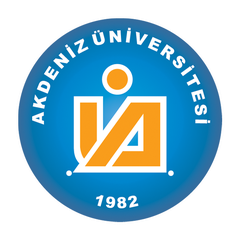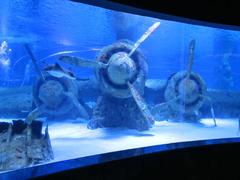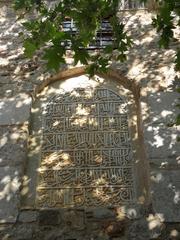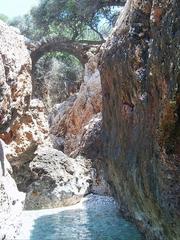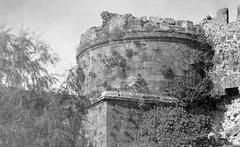Acalissus Visiting Hours, Tickets, and Historical Sites Guide – Antalya, Turkey
Date: 14/06/2025
Introduction
Nestled in the tranquil foothills of the Taurus Mountains in Antalya Province, the ancient city of Acalissus (also known as Akalissos) is a remarkable yet often overlooked relic of the Lycian civilization. While more famous sites like Xanthos, Patara, and Perge attract the majority of visitors, Acalissus offers an intimate and authentic experience for travelers seeking to uncover the region’s layered history. With origins tracing back to the Classical period and continuous habitation through the Byzantine era, Acalissus was a notable member of the Lycian League—a federation known for its pioneering democratic principles. Visitors can explore characteristic features such as polygonal masonry walls, rock-cut tombs, necropoleis, and the remnants of civic buildings, all set against dramatic mountain backdrops.
Despite limited large-scale excavations, Acalissus is valued for its blend of Lycian, Greco-Roman, and early Christian influences. Its inland strategic position once made it a key player in the trade routes between the Lycian coast and Anatolia’s interior. The site is particularly well-suited to travelers seeking serenity, historical depth, and off-the-beaten-path adventure in Antalya (Antalya Guide for Culture, Daily Sabah, Turkey Trip Guide).
This comprehensive guide provides essential details for planning your visit, including Acalissus visiting hours, ticket information (free entry), accessibility tips, travel advice, suggested itineraries, and recommendations for responsible tourism.
Table of Contents
- Discovering Acalissus: Why Visit?
- Historical Overview of Acalissus
- Archaeological and Cultural Highlights
- Practical Visitor Information
- What to See and Do at Acalissus
- Combining Acalissus with Nearby Attractions
- Sample Antalya Itinerary Incorporating Acalissus
- Frequently Asked Questions (FAQs)
- Responsible Tourism and Preservation
- Visuals and Media
- References
Discovering Acalissus: Why Visit?
Acalissus offers a rare opportunity to explore a genuine Lycian city amid peaceful surroundings. Unlike Antalya’s bustling, well-known sites, Acalissus promises solitude and a sense of discovery. The site’s archaeological integrity, unspoiled landscapes, and evocative ruins make it a must-visit for history enthusiasts, archaeologists, photographers, and adventure travelers seeking a more personal connection with Turkey’s ancient heritage.
Historical Overview of Acalissus
Located in southwestern Turkey’s Antalya Province, Acalissus was continuously inhabited from the Classical period through Roman and Byzantine times. As a city-state of the Lycian League, Acalissus minted its own coins and played a part in regional governance. The city’s religious and cultural life blended indigenous Lycian customs with Greek and Roman traditions, later embracing Christianity and becoming a bishopric during the Byzantine era. Acalissus declined in importance after the Byzantine period, likely due to shifting trade routes and regional instability.
Archaeological and Cultural Highlights
Urban Layout and Fortifications
Acalissus was constructed atop a defensible height, with polygonal masonry walls dating from the Hellenistic or early Roman eras. These fortifications reflect the city’s strategic role in regional defense during times of political change (Antalya Guide for Culture).
Necropolis and Funerary Monuments
The city’s slopes are dotted with distinctive Lycian rock-cut tombs and sarcophagi, many with inscriptions and reliefs reflecting the multicultural influences of Lycia. These monuments offer insight into the social structure and beliefs of Acalissus’s inhabitants.
Public Buildings and Inscriptions
Remains of public structures—such as the agora, bouleuterion (council house), and possible temples—are found throughout the site. Inscriptions and coins attest to Acalissus’s autonomy and its involvement in the Lycian League.
Acalissus within the Lycian League
As a member of the Lycian League, Acalissus participated in one of the earliest known federated democratic systems, a model that influenced later governments worldwide (Daily Sabah).
Recent Discoveries in Antalya Province
Antalya Province continues to be a hotspot for archaeological discovery, with hundreds of new artifacts unearthed annually. While Acalissus awaits large-scale excavation, nearby sites like Myra, Arykanda, and Aspendos have yielded significant finds, underscoring the region’s historical richness (Daily Sabah).
Role in Antalya’s Cultural Heritage
Artifacts from Acalissus and other Lycian sites are displayed in the Antalya Archaeological Museum, providing broader context for visitors interested in the region’s ancient civilizations.
Practical Visitor Information
Visiting Hours, Tickets, and Entry
- Hours: Acalissus is accessible year-round during daylight hours—typically from 8:00 AM to 6:00 PM. There are no formal entrance gates; visiting outside daylight is not recommended due to safety.
- Tickets: The site is free to enter. There are no ticket offices or on-site staff.
- Facilities: There are no restrooms, cafes, or shops at Acalissus. The nearest amenities are in Finike or nearby villages.
Accessibility and Getting There
- Location: Acalissus is near the village of Akalissos in the Finike district, approximately 120 km (about 2 hours’ drive) southwest of Antalya city center.
- By Car: The D400 coastal highway leads toward Finike, followed by rural roads inland to the site. GPS or offline maps are recommended (This is Antalya).
- Public Transport: No direct public transport. Visitors can reach Finike by bus, then arrange a taxi or private transfer.
- Tour Operators: Few mainstream tours include Acalissus, but private guides may be arranged in Antalya or Finike.
What to Bring and Visitor Tips
- Footwear: Sturdy walking shoes or hiking boots are essential due to uneven terrain and overgrown paths (The Not So Innocents Abroad).
- Water and Snacks: Bring your own, as there are no vendors at the site.
- Sun Protection: A hat, sunscreen, and sunglasses are crucial, especially in summer.
- Navigation: GPS or smartphone with offline maps is helpful for both reaching and exploring the site.
- Camera: The ruins and views are highly photogenic.
- Season/Time: Spring and autumn offer the best weather; early morning or late afternoon light is ideal for photography (Magnificent Travel).
Safety and Etiquette
- Terrain: The site is rugged and not wheelchair accessible. Children should be supervised.
- Preservation: Do not climb on ruins or remove artifacts; carry out all trash.
- Local Customs: Dress modestly and greet villagers politely if passing through rural areas.
What to See and Do at Acalissus
- Explore the Ruins: Wander among the remains of city walls, the acropolis, agora, and bouleuterion. Discover the photogenic rock-cut tombs and sarcophagi of the necropolis.
- Enjoy Panoramic Views: The acropolis offers sweeping vistas of the Taurus Mountains and surrounding valleys.
- Photography: Capture the atmospheric ruins, ancient masonry, and Mediterranean flora.
- Guided Exploration: Private guides can provide historical context and enrich your visit.
- Relax in Nature: The serene environment lends itself to contemplation and immersion in the natural landscape.
Combining Acalissus with Nearby Attractions
Acalissus is ideally combined with other Lycian and Greco-Roman sites for a full-day or multi-day itinerary:
- Arykanda: Renowned for its theater, baths, and hillside setting (about 30 km northeast).
- Limyra: Known for monumental tombs and a Roman bridge (about 20 km south).
- Finike: Offers accommodation, dining, and a charming harbor.
- Myra, Patara, Xanthos: Iconic Lycian cities with extensive ruins within driving distance (Property Turkey).
Nature lovers can also explore the Taurus Mountains and sections of the Lycian Way hiking trail.
Sample Antalya Itinerary Incorporating Acalissus
Day 1–2: Antalya Old Town (Kaleiçi), Hadrian’s Gate, Antalya Museum
Day 3: Perge and Aspendos
Day 4: Phaselis or Olympos ruins and beaches
Day 5: Limyra and Acalissus
Day 6: Arykanda, then return via Finike or continue to Demre (Myra)
Day 7: Optional: Kaş, Kekova’s sunken city, or additional Lycian sites
This itinerary balances major highlights with off-the-beaten-path discoveries.
Frequently Asked Questions (FAQs)
Q: What are Acalissus’s visiting hours?
A: The site is open year-round during daylight hours, typically 8:00 AM to 6:00 PM.
Q: Is there an entrance fee or ticket required?
A: No, Acalissus is free to enter and does not require tickets.
Q: Is the site accessible for people with disabilities?
A: Due to rugged, uneven terrain, Acalissus is not suitable for wheelchairs or visitors with limited mobility.
Q: Are there guided tours?
A: Official tours are rare, but private guides can be arranged in Antalya or Finike.
Q: What should I bring?
A: Sturdy shoes, water, snacks, sun protection, and a camera.
Q: What is the best season to visit?
A: Spring (April–June) and autumn (September–November) for mild temperatures and pleasant weather.
Responsible Tourism and Preservation
As a lightly managed archaeological site, Acalissus relies on respectful visitor conduct. Please:
- Avoid climbing on ruins or removing stones/artifacts.
- Carry out all trash—there are no disposal facilities.
- Respect the tranquility of the site and the natural environment.
- Support local businesses and guides to benefit the rural community.
Your responsible visit helps conserve this cultural treasure for future generations.
Visuals and Media
[Insert high-quality images of Acalissus ruins, city walls, necropolis, and panoramic views with descriptive alt text such as “Acalissus city walls and gates in Antalya historical sites” and “Panoramic view from Acalissus acropolis”].
For virtual tours and more visuals, visit official Antalya tourism websites and reputable travel blogs.
References
- Antalya Guide for Culture
- Daily Sabah
- Turkey Trip Guide
- Everyday Turkey Tours
- Travsl
- The Turkey Traveler
- Property Turkey
- Magnificent Travel
- This is Antalya
- The Not So Innocents Abroad
Final Tips
Acalissus is a hidden jewel for those who value history, tranquility, and authentic exploration. Its lack of commercialization, coupled with evocative ruins and mountain vistas, makes it an ideal destination for independent travelers and lovers of ancient civilizations. With advance planning and respect for the site’s archaeological sensitivity, your visit to Acalissus will undoubtedly become a highlight of your Antalya journey.
For updates, tailored itineraries, and offline maps, download the Audiala app. Follow official tourism channels for the latest on Antalya’s ancient sites.
